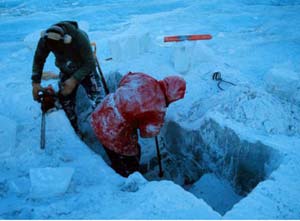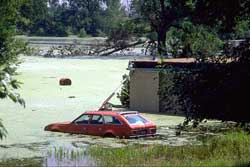Earth Sciences
Earth Sciences (also referred to as Geosciences), which deals with basic issues surrounding our planet, plays a vital role in the area of energy and raw materials supply.
Earth Sciences comprises subjects such as geology, geography, geological informatics, paleontology, mineralogy, petrography, crystallography, geophysics, geodesy, glaciology, cartography, photogrammetry, meteorology and seismology, early-warning systems, earthquake research and polar research.

Hitchhiking rocks provide details of glacial melting in West Antarctic
Rocks deposited by glaciers on mountain ranges in West Antarctica have given scientists the most direct evidence yet that parts of the ice sheet are on a long-term, natural trajectory of melting.
The West Antarctic Ice Sheet has been melting and contributing water continuously to the ocean for the last 10,000 years and is likely to keep doing so, says John Stone, University of Washington associate professor of Earth and space sciences.
Measuring and understanding changes in the Eart

Livermore researchers determine biosphere unaffected by geoengineering schemes
Using models that simulate the interaction between global climate and land ecosystems, atmospheric scientists from the Lawrence Livermore National Laboratory have shown that compensating for the carbon dioxide “greenhouse effect” by decreasing the amount of sunlight reaching the planet (geoengineering) could create a more vigorous ecosystem while helping to curb global warming.
The study suggests that planetary-scale engineering projects to lessen the amount of solar radiation reaching the

Researchers uncover extreme lake – and 3000-year-old microbes – in Mars-like antarctic environment
NSF-supported researchers drilling into Lake Vida, an Antarctic “ice-block” lake, have found the lake isn’t really an ice block at all. In the December 16 issue of the Proceedings of the National Academy of Sciences, the team reveals that Antarctic Lake Vida may represent a previously unknown ecosystem, a frigid, “ice-sealed,” lake that contains the thickest non-glacial lake ice cover on Earth and water seven times saltier than seawater.
Because of the arid, chilled environment in which i

Waves in the atmosphere batter south pole, shrink 2002 ozone hole
A greater number of large “planetary sized waves” in the atmosphere that move from the lower atmosphere into the upper atmosphere were responsible for the smaller Antarctic ozone hole this fall, according to NASA researchers. The September 2002 ozone hole was half the size it was in 2000. However, scientists say that these large-scale weather patterns in the Earth’s atmosphere are not an indication that the ozone layer is recovering.
Paul Newman, a lead researcher on ozone at NASA’

Will Climate Change Temper El Niño’s Tantrums?
The broad-scale warming expected from increased greenhouse gases may actually sap the strength of a typical El Niño, according to researchers at the National Center for Atmospheric Research (NCAR) in Boulder, Colorado. In contrast, the average El Niño during the last ice age may have packed more punch than today’s. The scientists have examined the past and future behavior of El Niño using a sophisticated computer model of global climate. They present their results this week at the annual meeting

Engineers work on their SUNTANS as they track waves and beaches
Nearly a month has passed since the wounded tanker Prestige spilled thousands of tons of heavy oil into the Atlantic and fouled dozens of Spanish beaches. But anxious residents of coastal Spain and Portugal remain on high alert – wondering where and when the noxious crude will wash ashore next.
In recent years, tanker accidents have ruined fisheries and tourist beaches from Alaska to France. But do oil spills always have to end in catastrophe? Perhaps the most vulnerable beaches and coastal